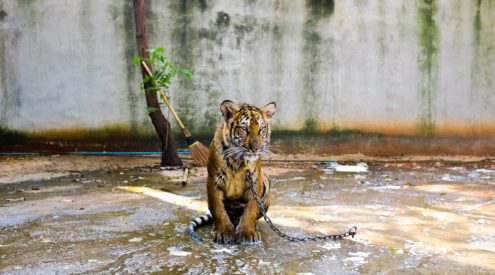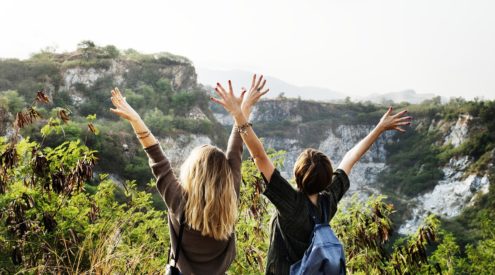Open Africa’a Kalahari Red Dune Route explores the area north of Upington into the Kgalagadi Transfrontier Park, a protected expanse that shares its borders with Namibia and Botswana and is one of the largest conservation areas in the world.
Open Africa is a social enterprise that establishes tourism routes so as to offer travellers authentic experiences while generating income for local businesses. They invited me on a surprise adventure early last month. I was so excited when I learnt that it would be a self-drive trip into the Kalahari, as I had never been to this part of South Africa before. The trip was a feast of fantastic landscapes, wildlife and cultural experiences unique to the region.
Why the red dunes?

Our guide took us for a morning walk where we read the ‘Kalahari News’ – the tracks in the dunes. Photo by Yann Macherez.
My research tells me that the colour of the dunes in the region is due to the high iron oxide content of the sand. In areas of higher rainfall and in shallow areas where water collects, the iron oxide gets leached out, causing the sand to turn white. The gradual effect of this leaching transforms the desert sand into a wonderful variety of colours. It really is spectacular.
Wide open roads and big skies

Enjoying the freedom of the open road. Photo by Yann Macherez.
Our trip started with a red-eye flight from Cape Town to Upington, thanks to Flight Centre Canal Walk. At the airport we picked up our Hertz rental car and left the airport unprepared, not knowing that we weren’t going to see any shops for the next 300km. (Note – stock up on water and padkos in Upington!)
As we headed north the scenery started changing. It was just big blue skies and wide open spaces. Basically lots of nothing. It was awesome. The road was quiet and empty. Besides a few passing vehicles, the only signs of life were the gigantic nests of the sociable weaver birds that seemed to colonise trees and electricity poles. The colonies have up to 50 chambers housing as many as 300 birds.
Our first stop was Molopo Lodge, an easy two-hour drive from the airport. The road to the Kgalagadi is long and straight, and famous for attracting speed freaks. In 2015, the Northern Cape’s Hakskeen Pan will become the venue for the Bloodhound team’s attempt to break the world landspeed record!

There are salt pans all over the Kalahari. Photo by Yann Macherez.
Tannie Koera’s Farm Kitchen

Tannie Koera cooks home style meals in her farm kitchen located on the R360 between Askham and Andriesvale. Image by Yann Macherez.
Just before we got to Molopo we saw a sign for Tannie Koera’s Farm Kitchen. We were super thirsty by this time, and decided to see if we could get some water here. We were so glad we stopped. Tannie Koera warmly welcomed us into her little farm kitchen offering us a much-appreciated drink of water.
Yann, my travel buddy and photographer friend was immediately in portrait heaven and started snapping away. We quickly learnt that the people of the Kalahari are some of the most friendly, open and photogenic people we’ve met. Tannie Koera told us about her kitchen, and the home-cooked traditional fare she cooked. Her English was as good as my Afrikaans, so chatting with her was an experience in itself!
After checking into our cabins at Molopo Lodge, it was time for a much-needed siesta to avoid the midday Kalahari heat. Molopo offers a variety of accommodation options from camping and caravan sites to bungalows, and tented cabins. We stayed in their sweet little tented cabins complete with decks and outside showers. They also have a good restaurant with a range of game options.
Experiencing ‡Khomani San culture

We went on a bush walk with Auche Raats of the San Living Museum where he taught us the basics of bushcraft. Photo by Yann Macherez.
Refreshed from our siesta, we set off to find the Living Museum, where we were excited to learn more about the local ‡Khomani San culture. Our guide Auche Raats took us for a bush walk where we learnt the ancient bushcrafts that he had learnt from his elders. He showed us how he tracked animals, hunted and the uses of various medicinal plants.
Kalahari trails

Toto the meerkat at Kalahari Trails. Photo by Yann Macherez.
The next day we were up early for a morning walk with Kalahari Trails. Here we met Toto, the rescued meerkat, and immediately fell in love. He was the cutest and most friendly little animal, and took to me quickly, sitting on my feet and climbing on my shoulders for a little cuddle, his little claws tickling my neck. After play session with Toto, our guide Andre Labuschaigne, took us for a walk through the dunes where we learnt about the different insect and animal tracks and even found spoor of the elusive aardvark. How I wished we could see an actual aardvark!
After our walk we chatted to to the wonderfully welcoming and knowledgable Professor Anne Rasa, owner of Kalahari Trails. Prof Rasa has spent the last 20 years researching the behavior and biology of the desert animals and entertained us with her stories of meerkats and her work in the Kalahari.
After the walk, we were famished. Or brunch stop was the nearby Kgalagadi Lodge where we were treated to a massive farm breakfast! If you’re self catering, this is also a good place to stock up on supplies.
!Xaus Lodge and the 90 dune road

At one with nature at !Xaus Lodge. Photo by Meruschka Govender.
Finally it was time to enter the Kgalagadi Park. After a petrol stop at Twee Rivieren camp, at the entrance to the park we started on our 60km drive to the Kamqua picnic site (meeting point for !Xaus Lodge). On the way we spotted wildebeest, ostrich, springbok and eland. We parked our little Hertz rental here and packed our bags in the lodge 4×4, driven by our guide Koos while the guests, with their own 4x4s, followed us into the red sand.
We then embarked on a hair-raising ride on the 90 dune road leading to !Xaus Lodge. At this time, I wished that we had our own 4×4. The 30km single-track soft sand road dune road looked like it would be so much fun to drive! (Note: if you tend to get motion sickness, you might want to take your anti-nausea meds before attempting this road!)
When we reached !Xaus Lodge we were warmly welcomed by the manager. !Xaus is a 12 room unfenced luxury lodge set on a dune, overlooking a huge pan. Our rooms were large wooden cabins, each with a private deck with views of the pan. Don’t expect cellphone reception or WiFi, this is as remote as you can get in South Africa!
Over the next two days we experienced nature at its finest – red dunes contrasted with white salt pans and skies of a billion stars. For those used to other South African parks, the Kgalagadi is a revelation. The semi-arid landscapes and dry pans are almost moon-like in parts. We spotted birds of prey, cheetah, hyena, bat-eared fox, yellow mongoose and gemsbok, but the Kalahari lion seemed to elude us. For me, the highlight was waking up before sunrise only to find two cheetah crossing the salt pan in front of the lodge. Magic!

Gemsbok at Kgalagadi Park. Photo by Yann Macherez.
The lodge offers morning walks, game drives, night drives and a visit to an on-site Bushman Craft Village, where local youth who have been relearning traditional crafts at local veldskools get to show their craft to tourists, and earn a supplementary income. I found the set up of the craft village to be rather staged, however I recognised the importance of keeping these traditional crafts alive.
!Xaus Lodge is owned by the ‡Khomani San and Mier communities, and is managed by Transfrontier Parks Destinations. !Xaus Lodge aims to empower local communities as almost all employees are from the local communities where unemployment is rife. Community trusts also receive monthly rental from the lodge based on its turnover. I was glad to learn that !Xaus Lodge is Fair Trade Tourism accredited and practices sustainable tourism.

Habu, 19, is from the local community and works at !Xaus Lodge. Besindes working ath the lodge, he goes to veldskool where he learns ancient bush craft from the elders. He learns how to be self-sufficient in the bush, and how to make handicrafts like the bushmen have been doing for centuries. Sadly many of these ancient traditions are being lost. Make no mistake, Xabu has a cellphone and aspires to be like any young man but understands the importance of his heritage.
On our last day of our trip, we were took the rollercoaster ride shuttle back on the 90 dune road. We picked up the car and did a little two-hour self-drive through the park before heading back up to Upington. It was sad to leave the Kalahari, but I was happy to have witnessed its natural beauty and rich cultural heritage. I hope to be back soon, there are so many stories waiting to be told.

Having a laugh with Barbara Raats and her uncle who are from the ‡Khomani San community. Photo by Yann Macherez.
To follow more of my adventures, check out my website, Mzansi Girl.


















